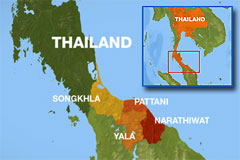The scars of Krue Se
South Thailand’s Krue Se mosque has become a symbol of a troubled region.

 |
| The walls have been repaired at Krue Se, but the scars remain |
It is not Thailand‘s biggest or most beautiful mosque, but it is the oldest and most famous.
And what happened at the Krue Se mosque in the southern province of Pattani more than three years ago continues to resonate throughout the troubled region.
| Family grief | ||
|
|
The mosque’s walls have been repaired, but the scars remain.
On April 28, 2004, the Thai army surrounded the mosque where it said 32 Malay Muslim separatists were holed up.
The men were among more than 100 who, the militray said, had attacked a dozen police stations and checkpoints across the south earlier in the day.
After an eight-hour standoff and exchanges of gunfire, the army attacked, killing everyone inside the mosque.
Khalijah Halee’s 63-year-old father, Mail, was killed in the attack.
| Exclusive interview | ||
|
|
She says he had never been a fighter and was not a separatist. He had simply gone to the mosque that day to pray.
“To this day, I believe my father couldn’t leave the mosque,” she says.
“Maybe somebody stopped him. I’m sure because he was a good man and never hurt anybody.”
‘Excessive’
Niseng Nileah was there too. He prayed with the fighters the morning of the siege and says he, and anyone else who wanted to, was allowed to leave before the army assault.
“They asked them to surrender and defend themselves in court,” he recalls.
“But they didn’t surrender. On the contrary, they wanted to fight and intended to die in the mosque.”
| Thailand’s troubled south |
|
Area was semi-autonomous Islamic Malay sultanate until annexed by Thailand in 1902 Several violent uprisings have been put down by army over the century. Latest uprising flared in 2004, leading to imposition of martial law One of deadliest incidents happened at Krue Se mosque in Pattani in April 2004, where an army raid left 32 dead |
Whether or not all of the men inside the mosque that day were separatist fighters, many believe the attack was unnecessary because they were only lightly armed and running out of ammunition.
A government investigation determined that the army’s use of force was “excessive”.
Chaiwat Satha-Anand, a political science professor at Thailand‘s Thammasat University and a member of the National Reconciliation Commission that produced the government report, says the scars from Krue Se remain very deep.
“For the people in the south, I think the symbolism of attacking of the mosque will stand very clearly as an affront against the religious identity that the people consider extremely sacred,” he says.
The inquiry also found that the general who ordered the attack disobeyed orders from Bangkok to give negotiations more time.
But General Pallop Pinmanee says he was made a scapegoat and that the report is unfair.
“I only regret that I didn’t attack earlier because if I had three of my men would still be alive,” the general said.
It’s that kind of attitude that Thailand‘s Malay Muslim minority says typifies the Thai government’s disrespect for their religion and culture – and disregard for their lives.
And the memories of what some call the “Krue Se mosque Massacre” continues to provide ammunition for those fighting for independence from Thailand.


